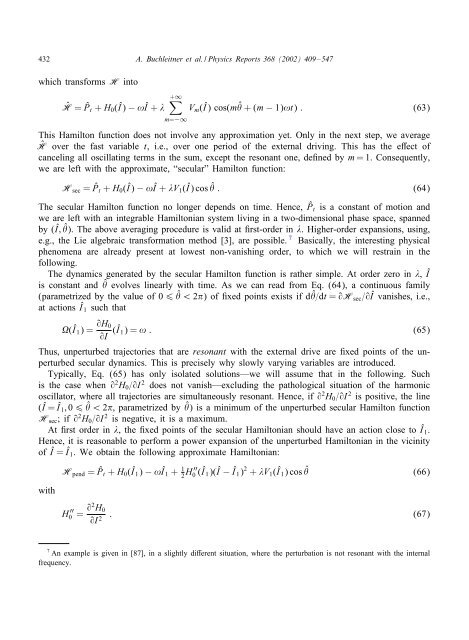Non-dispersive wave packets in periodically driven quantum systems
Non-dispersive wave packets in periodically driven quantum systems
Non-dispersive wave packets in periodically driven quantum systems
Create successful ePaper yourself
Turn your PDF publications into a flip-book with our unique Google optimized e-Paper software.
432 A. Buchleitner et al. / Physics Reports 368 (2002) 409–547<br />
which transforms H <strong>in</strong>to<br />
ˆH = ˆPt + H0(Î) − !Î +<br />
+∞<br />
m=−∞<br />
Vm(Î) cos(m ˆ +(m − 1)!t) : (63)<br />
This Hamilton function does not <strong>in</strong>volve any approximation yet. Only <strong>in</strong> the next step, we average<br />
ˆH over the fast variable t, i.e., over one period of the external driv<strong>in</strong>g. This has the e ect of<br />
cancel<strong>in</strong>g all oscillat<strong>in</strong>g terms <strong>in</strong> the sum, except the resonant one, de ned by m = 1. Consequently,<br />
we are left with the approximate, “secular” Hamilton function:<br />
Hsec = ˆPt + H0(Î) − !Î + V1(Î) cos ˆ : (64)<br />
The secular Hamilton function no longer depends on time. Hence, ˆPt is a constant of motion and<br />
we are left with an <strong>in</strong>tegrable Hamiltonian system liv<strong>in</strong>g <strong>in</strong> a two-dimensional phase space, spanned<br />
by (Î; ˆ ). The above averag<strong>in</strong>g procedure is valid at rst-order <strong>in</strong> . Higher-order expansions, us<strong>in</strong>g,<br />
e.g., the Lie algebraic transformation method [3], are possible. 7 Basically, the <strong>in</strong>terest<strong>in</strong>g physical<br />
phenomena are already present at lowest non-vanish<strong>in</strong>g order, to which we will restra<strong>in</strong> <strong>in</strong> the<br />
follow<strong>in</strong>g.<br />
The dynamics generated by the secular Hamilton function is rather simple. At order zero <strong>in</strong> , Î<br />
is constant and ˆ evolves l<strong>in</strong>early with time. As we can read from Eq. (64), a cont<strong>in</strong>uous family<br />
(parametrized by the value of 0 6 ˆ ¡2 ) of xed po<strong>in</strong>ts exists if d ˆ =dt = 9Hsec=9Î vanishes, i.e.,<br />
at actions Î 1 such that<br />
(Î 1)= 9H0<br />
9I (Î 1)=!: (65)<br />
Thus, unperturbed trajectories that are resonant with the external drive are xed po<strong>in</strong>ts of the unperturbed<br />
secular dynamics. This is precisely why slowly vary<strong>in</strong>g variables are <strong>in</strong>troduced.<br />
Typically, Eq. (65) has only isolated solutions—we will assume that <strong>in</strong> the follow<strong>in</strong>g. Such<br />
is the case when 9 2 H0=9I 2 does not vanish—exclud<strong>in</strong>g the pathological situation of the harmonic<br />
oscillator, where all trajectories are simultaneously resonant. Hence, if 9 2 H0=9I 2 is positive, the l<strong>in</strong>e<br />
(Î = Î 1; 0 6 ˆ ¡2 , parametrized by ˆ ) is a m<strong>in</strong>imum of the unperturbed secular Hamilton function<br />
Hsec; if9 2 H0=9I 2 is negative, it is a maximum.<br />
At rst order <strong>in</strong> , the xed po<strong>in</strong>ts of the secular Hamiltonian should have an action close to Î 1.<br />
Hence, it is reasonable to perform a power expansion of the unperturbed Hamiltonian <strong>in</strong> the vic<strong>in</strong>ity<br />
of Î = Î 1. We obta<strong>in</strong> the follow<strong>in</strong>g approximate Hamiltonian:<br />
with<br />
Hpend = ˆPt + H0(Î 1) − !Î 1 + 1 ′′<br />
H 2 0 (Î 1)(Î − Î 1) 2 + V1(Î 1) cos ˆ (66)<br />
H ′′<br />
0 = 92 H0<br />
9I 2 : (67)<br />
7<br />
An example is given <strong>in</strong> [87], <strong>in</strong> a slightly di erent situation, where the perturbation is not resonant with the <strong>in</strong>ternal<br />
frequency.











